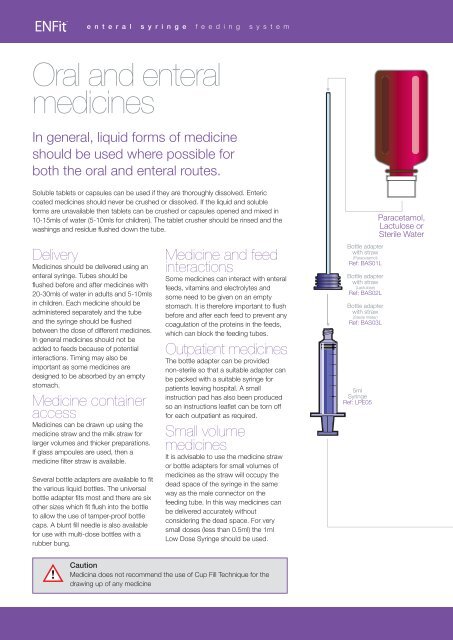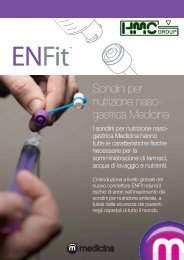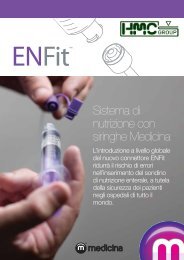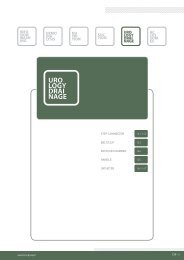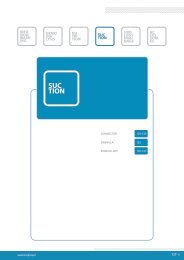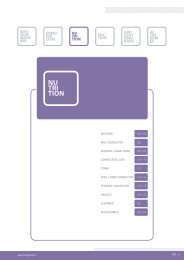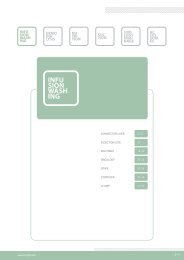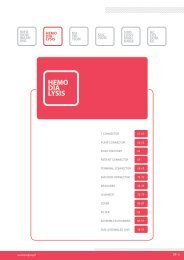You also want an ePaper? Increase the reach of your titles
YUMPU automatically turns print PDFs into web optimized ePapers that Google loves.
e n t e r a l s y r i n g e<br />
f e e d i n g s y s t e m<br />
Oral and enteral<br />
medicines<br />
In general, liquid forms of medicine<br />
should be used where possible for<br />
both the oral and enteral routes.<br />
Soluble tablets or capsules can be used if they are thoroughly dissolved. Enteric<br />
coated medicines should never be crushed or dissolved. If the liquid and soluble<br />
forms are unavailable then tablets can be crushed or capsules opened and mixed in<br />
10-15mls of water (5-10mls for children). The tablet crusher should be rinsed and the<br />
washings and residue flushed down the tube.<br />
Delivery<br />
Medicines should be delivered using an<br />
enteral syringe. Tubes should be<br />
flushed before and after medicines with<br />
20-30mls of water in adults and 5-10mls<br />
in children. Each medicine should be<br />
administered separately and the tube<br />
and the syringe should be flushed<br />
between the dose of different medicines.<br />
In general medicines should not be<br />
added to feeds because of potential<br />
interactions. Timing may also be<br />
important as some medicines are<br />
designed to be absorbed by an empty<br />
stomach.<br />
Medicine container<br />
access<br />
Medicines can be drawn up using the<br />
medicine straw and the milk straw for<br />
larger volumes and thicker preparations.<br />
If glass ampoules are used, then a<br />
medicine filter straw is available.<br />
Several bottle adapters are available to fit<br />
the various liquid bottles. The universal<br />
bottle adapter fits most and there are six<br />
other sizes which fit flush into the bottle<br />
to allow the use of tamper-proof bottle<br />
caps. A blunt fill needle is also available<br />
for use with multi-dose bottles with a<br />
rubber bung.<br />
Medicine and feed<br />
interactions<br />
Some medicines can interact with enteral<br />
feeds, vitamins and electrolytes and<br />
some need to be given on an empty<br />
stomach. It is therefore important to flush<br />
before and after each feed to prevent any<br />
coagulation of the proteins in the feeds,<br />
which can block the feeding tubes.<br />
Outpatient medicines<br />
The bottle adapter can be provided<br />
non-sterile so that a suitable adapter can<br />
be packed with a suitable syringe for<br />
patients leaving hospital. A small<br />
instruction pad has also been produced<br />
so an instructions leaflet can be torn off<br />
for each outpatient as required.<br />
Small volume<br />
medicines<br />
It is advisable to use the medicine straw<br />
or bottle adapters for small volumes of<br />
medicines as the straw will occupy the<br />
dead space of the syringe in the same<br />
way as the male connector on the<br />
feeding tube. In this way medicines can<br />
be delivered accurately without<br />
considering the dead space. For very<br />
small doses (less than 0.5ml) the 1ml<br />
Low Dose Syringe should be used.<br />
Bottle adapter<br />
with straw<br />
(Paracetamol)<br />
Ref: BAS01L<br />
Bottle adapter<br />
with straw<br />
(Lactulose)<br />
Ref: BAS02L<br />
Bottle adapter<br />
with straw<br />
(Sterile Water)<br />
Ref: BAS03L<br />
5ml<br />
Syringe<br />
Ref: LPE05<br />
Paracetamol,<br />
Lactulose or<br />
Sterile Water<br />
Caution<br />
Medicina does not recommend the use of Cup Fill Technique for the<br />
drawing up of any medicine


